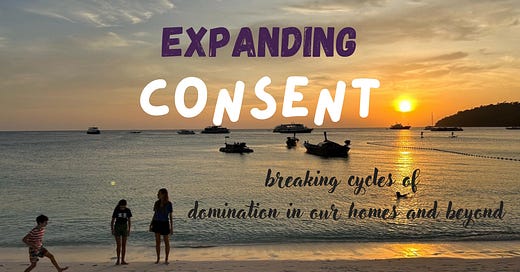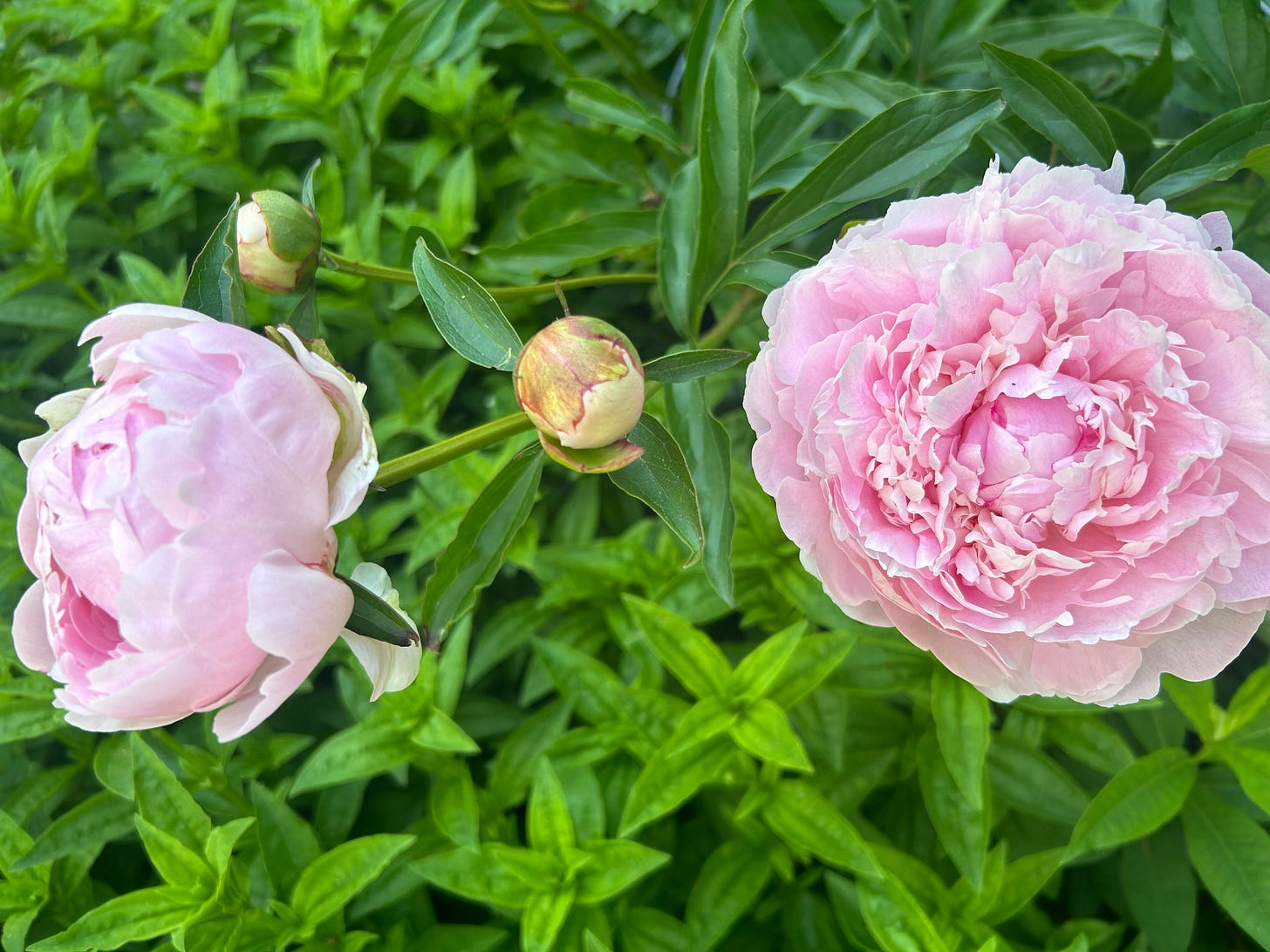Part II.
Cultures of Consent: the inner landscape
Part II of my book is all about identifying what a culture of consent looks like, and how we work to co-create one.
You can read the first four chapters of my book under BOOK: Expanding Consent.
Chapter Five
Shifting the cultural and inner landscapes
It’s all in the broth
A few days ago I was scrolling through instagram and I saw a meme: “Shame cannot survive in safe spaces,” it declared. It stuck with me, and I later realized it was perhaps a reference to Ann Voskamp’s quote, “Shame dies when stories are told in safe places.”
It’s the opposite with consent. Consent thrives in spaces that allow it to survive and flourish. And while it might look like it’s happening regardless, consent becomes performative in spaces that have none of the elements it needs.
I know this, because this was once my home. I cared about consent, and I wanted to be in consent-based relationship with my children, but I hadn’t looked closely at the sort of environment where consent can live and thrive.
It outwardly appeared to be happening.
Our children may be agreeing to do the things we suggest, and might seem to be happily going along with things, and we feel like everybody agrees on the house rules – by all appearances, we are all making consent-based decisions!
The thing is, consent-based decisions and relationships express themselves best if you’ve actively co-created a culture of consent.
Brené Brown says this about shame: “If you put shame in a petri dish, it needs three ingredients to grow exponentially: secrecy, silence, and judgment. If you put the same amount of shame in the petri dish and douse it with empathy, it can't survive.”
It’s a similar thing with consent: if you put consent in a petri dish full of judgement and shame (to name two elements that do not belong in consent culture), consent becomes a withered version of itself. If you place consent in a culture of consent, which includes ingredients like trust, non-judgment, and awareness of power dynamics, it survives and thrives.
Think of consent culture as the broth you’re cooking your vegetables in. Without the broth, you only have boiled carrots and potatoes. The broth is the flavor, texture, colour and spice of consent. You can eat boiled carrots and potatoes but they won’t taste that good on their own. You need the broth.
The broth is the foundation of your soup. Without it, you just have boring boiled veg.
Consent culture is our outer landscape
Consent culture is the broth to our soup, the ingredients to our petri dish..
You can go about your life believing you are honouring consent in your young people, asking questions and receiving a yes, or coming to collaborative agreements, but if the sea you are swimming in is toxic, their yeses and their agreements could be a survival mechanism rather than an expression of their autonomy. Simply put, if they fear your response to their genuine feelings, they might be telling you what they know you want to hear.
I have known this. There was a time my child’s apparent compliance was just that – their way to survive, to be loved and to not be judged.
I also see this as an adult living under colonial capitalism: my compliance with our systems is not a reflection of how patriarchy and capitalism are rooted in consent (they are not), but a reflection of the ways we are simply trying to survive, to be loved, to seek compassion.
The soup I mentioned above, is the culture of consent we are working to create, both inside and outside our home. It is where our young people’s wholeness and consent-based expression can flourish, and where our own wholeness and consent-based expression can flourish.
Erica Scott & Marcia Baczynski write about how we grow up learning that power differentials are all around us, and how this normalises them and and they “set the stage for consent violations, both conscious and unconscious.” They write, “This is why we can’t take consent out of the context of culture.”
Sophie Christophy has spoken about how this cannot happen if we don’t inherently feel we are worthy of love and belonging, just for being us. She said, “There is a direct connection between informed consent and self-worth, and there is a direct connection between patriarchy, and the beginning of systemic imbalances, and the systemic stripping of self-worth from entire groups of people.”
There is no consent - or at any rate, it might be a lot more challenging to enact consent-based practice - outside of a culture of consent. The cultural shift is just as important as the shift in the ways we actually practice consent.
“We must shift the culture to create an environment for consent to truly flourish,” write Scott and Baczynksi, and I’m going to talk more about that.
But first, a story.
Let me tell you a story about consent
A child goes to school. They are told they are a joy to teach, so they seek to please. They make friends, and they love to learn new things, so they enjoy going every day. They don’t know there is another way, because everyone else they know goes to school and it was never an option not to go. And it’s not such a big deal to go, it’s often kind of fun. They do their homework, and they read the books they can tell their parents and teachers want them to read, and hide the ones that are met with eyerolls and disapproval and sneak-read them at night. They know their parents wouldn’t approve, even though they never said as much.
They hide parts of themselves. Like the part that loves to sing silly songs, and dance, and wear tiaras. They squeeze themselves in the boxes their parents have made for them – clever, sporty, kind. They don’t feel any of those things, but they hide it.
When their mother asks to go for a walk, they say yes because they knows mum loves walking, and being outdoors. But really, they would rather sit on the sofa and read.
When their father urges them to try new food, they do, even though they don’t want to.
They carry around a feeling that nobody really wants to see them as they actually are. That people would rather they fit into an image of a child they’ve created, rather than face the real person in front of them. They feel like perhaps the person they really are is somehow wrong, incomplete, unworthy.
They feel caught in a cycle of having to please the adults around them, to maintain an image of themselves those adults created in the first place.
This child is nobody I know, but they are also bits of many people.
There was never a point where consent was explicitly violated, where the child said no and was overridden, but there were hundreds of quiet moments when the child could have been seen and heard for who they really were, but they were not.
This too, is what consent-based means.
Seeing our child for the person they are, not the person we wish they were. Seeing ourselves for who we really are, not who we wish we were.
And loving them both anyway.
This kind of consent-based exchange can only happen when we tend to our outer landscape, to the culture we are building in our home.
The sea we swim in
We live part of the time on the coast of Maine, where the Atlantic Ocean kisses rocky and pebbly shores, and our beaches are at least partially shielded by Penobscot Bay. We find periwinkles on beaches of granite boulders, and pull mussels out of the clay flats. Our bay hosts a very specific ecosystem: our communities fish lobsters and crabs, they harvest mussels and oysters. We spot seals and porpoises and occasionally there is a whale sighting. We live and die by the dramatic tides. Our ponds are home to frogs and beavers. These ecosystems are perfect for the life that lives within them.
So, too, our home culture will ideally be conducive to consent-based-ness FOR US. While our sea might be the darkest shade of green, yours might be clear and turquoise. While our ocean is cold, yours might be shallow and warm. We see porpoises skipping around our boat, and you might see tiger sharks and sting rays.
Every consent culture is different. There is no one universal culture of consent, there is no one right way to do it. The environment you create in your home will be as close to ideal for your people, culturally-specific, and rooted in time and place. Your culture of consent is what makes consent work for you, your family, your community.
These conditions make up a culture of consent, even before you start to actually practice consent-based relationships. The practice of these relationships is reliant on all the conditions of consent culture - in the sense that consent-based choices won’t really be consent-based if we haven’t laid the groundwork for them to be. They will just be a performance.
You never arrive
I want to frame a culture of consent as a work in progress. It shifts and changes, much like the ocean itself. It’s not always perfectly balanced. We are always working towards something that feels good for us all, but there is no ideal even in our home because there is ideal ocean.
Some of us like rough, murky waters and some enjoy clear, warm ones. There is no one sea where all creatures thrive, and in the same way our cultures of consent will vary day by day. They are constantly evolving and we know we will never arrive. We will mess up and some days nobody will want to even try look at the sea. That is okay.
I made a handy little wheel
The elements you see on the Wheel are the groundwork, the things we are working on in the background; broad areas that contribute to creating a culture where consent can do its thing unhampered and authentically. They are: self-consent, growing awareness of power imbalances and hierarchies, Unconditional Positive Regard, non-judgment, trust and relationship, autonomy, boundaries and mutuality.
Paying attention to these elements radically changed things for me and my children, and I believe they could work for your family too.
In the following chapters, I’m going to dive deeper into the various elements that make up a culure of consent.
Thanks for reading and supporting my newsletter while I work on healing my hand and being able to type again!!
Sending you all lots of love,








Fran - that is a terrific Wheel of Consent
with all the elements involved
[and probably things we haven't talked about yet].